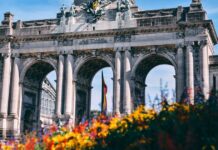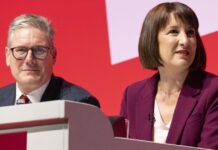What’s really behind Donald Trump’s tariff threats and ’51st state’ posts about Canada
Donald Trump’s threat of whopping tariffs on Canadian exports and his trolling of Prime Minister Justin Trudeau are key tactics in a negotiating strategy to extract the best trade terms for the U.S., according to people who have worked with or closely observed him over the years.
Trump is promising to slap a 25 per cent tariff on all goods entering the U.S. from Canada and Mexico on Jan. 20, his first day in office, unless the countries curb the flow of drugs and migrants across their borders.
The president-elect has since followed up that threat by taunting Trudeau by calling him “governor” and referring to Canada as the “51st state” in a succession of social media posts.
Analysts say this approach echoes the trademark negotiating style that Trump has employed for many years, both in business and the presidency.
Stephen Moore, who served as an economic adviser to Trump during his first term in the White House, says the president-elect is aiming to get leverage in renegotiating the three-way trade agreement between the U.S., Canada and Mexico.
“I think there’s no question that that’s what he’s doing here,” Moore said in an interview with CBC News.

“I’ve seen Trump up-front and personal over his presidency and I’ve talked to him quite a bit about this,” said Moore, now a senior economist at the conservative Heritage Foundation.
“He uses the threat of tariffs to get countries to do things that he thinks are in America’s national security and economic interests.”
Strategy ‘worked out pretty well’ in 1st term
Although Moore is no fan of tariffs from the perspective of their impact on the economy, he understands why Trump is threatening to impose them on Canada and Mexico.
“He wants to make sure that the trade deals that we have are fair for American workers and American companies,” he said. “That’s been a strategy that worked out pretty well in the first term, and I hope it will in the second term as well.”
Trump used the one-two punch of tariffs and taunts against Canada in 2018 during the talks that led to the Canada-U.S.-Mexico Agreement (CUSMA). He slapped tariffs on steel and aluminum, threatened tariffs on auto exports and called Trudeau “very dishonest and weak.”
Eugene B. Kogan, who teaches advanced negotiation skills at Harvard and has written about Trump’s negotiating style, says the president-elect has long used the tactic of denigrating his competition as a way of gaining leverage.

“Prime Minister Trudeau is in political trouble at home, and I think that president-elect Trump is sensing the weakness,” said Kogan in an interview with CBC News. “He smells blood.”
He says that Trump “is an incredibly rational, brutally ruthless analyst of human weakness and political weakness, and that is when he senses most of his leverage.”
He believes Trump thinks “on an almost 24-hour basis” about how to exploit an opponent’s vulnerabilities and turn them into opportunities for gain.
Launching a threat of stiff tariffs against such a longstanding trading partner even before taking office is emblematic of what Kogan describes as Trump’s “win-lose” approach to negotiations.
Power move to establish leverage
“He is making a power move driven by the desire to establish his leverage,” Kogan said. “The underlying message is, ‘I will make it unpredictable for the other side, so much that the other side will be under pressure to make concessions.’ ”
Trump’s transition team did not respond to a request for comment.

There are a range of observers from Wall Street to Bay Street to Congress who view Trump’s tariff salvo against Canada and Mexico as a means of gaining leverage in talks on the three-way trade deal, which comes up for renewal in 2026.
-
“This latest tariff threat effectively marks the start of negotiations,” said international wealth management firm UBS Global in a recent briefing note.
-
“Trump’s best and most likely use of tariffs are as a bargaining chip to force Canada into concessions” when CUSMA is renegotiated, wrote TD economist Marc Ercolao.
-
“Right now, I see everything that Trump’s doing on tariffs as a negotiating tool,” said Iowa Republican Sen. Chuck Grassley, according to Politico.
Trump’s pick for treasury secretary, Scott Bessent, praised the president-elect for using tariffs as “a negotiating tool with our trading partners,” in an opinion piece published on the Fox News website shortly after the election.
Marc Thiessen, a chief speechwriter for former U.S. president George W. Bush and a fellow at the American Enterprise Institute, said last week that Trump is both serious about imposing tariffs on Canada and about using them to negotiate.
“If they don’t come around and do what he wants them to do, then he will slap those tariffs on them,” Thiessen told Fox News. “I think he also knows that Justin Trudeau is incredibly weak.”
U.S. president-elect Donald Trump claimed on social media that he urged hockey icon Wayne Gretzky to run for prime minister during a Christmas visit. It’s Trump’s latest comment on Canadian politics, following quips about Canada becoming the U.S.’s 51st state and meeting ‘Governor’ Justin Trudeau.
On Christmas Day, Trump posted that he’d urged Wayne Gretzky to “run for Prime Minister of Canada” and that the hockey legend “would win easily.” He has also mused about buying Greenland and taking control of the Panama canal.
Trump’s comments about Canada, Mexico, Greenland and Panama are tied together by the common thread of countering Russia and China, an unnamed transition official told the Washington Post.
“This isn’t just slapdash, there’s a coherent connective tissue to all of this,” the Post quoted the official as saying. “Trump knows what levers to pull.”
Even if there’s consensus that Trump’s tactics when it comes to Canada are designed to gain leverage, a big question that remains unanswered is what his end goal could be.
Many doubt that a crackdown on fentanyl trafficking and illegal migration — Trump’s stated reasons behind the tariff threat — is all he wants.
That view was given some credence on Friday when two Trudeau cabinet ministers met two of Trump’s cabinet picks in Florida to brief them on Canada’s plan for improving border security.
Foreign Affairs Minister Mélanie Joly and Finance Minister Dominic LeBlanc travelled to Florida on Friday to discuss potential tariffs with representatives of the incoming Trump administration.
A senior Canadian government source told CBC’s Katie Simpson that Trump’s fixation with the U.S. trade deficit with Canada came up at the meeting.
Trump has repeatedly — and inaccurately — characterized the trade imbalance as the U.S. subsidizing Canada.
Crude oil imports drive U.S. trade deficit
The trade deficit, which ran about $75 billion US in 2023, is largely the result of Canada’s record-high crude oil exports to its southern neighbour.
The U.S. imported more petroleum from Canada last year than from all other countries combined, according to statistics from the U.S. Energy Information Administration.
Moore says he thinks Trump’s objective is to make North America “geopolitically the most important region in the world when it comes to energy.”
In his 1987 book The Art of the Deal, Trump wrote, “Leverage: don’t make deals without it.” There’s plenty of evidence that nearly 40 years later he is still following that maxim.
Published at Sun, 01 Dec 2024 09:01:00 +0000
After deadly South Korean plane crash, airport’s runway design criticized
Air safety experts on Tuesday questioned the placement of an airport embankment into which a South Korean passenger jet slammed after skidding past the end of the runway, resulting in the country’s deadliest domestic air disaster.
All 175 passengers and four of the six crew were killed on Sunday when the Jeju Air 089590.KS plane belly-landed at Muan International Airport, plowed into the sand-and-concrete embankment and burst into a fireball. Two crew members were pulled out alive.
What caused the pilot to attempt the landing after declaring an emergency was still under investigation.
But comments in the airport’s operating manual, uploaded early in 2024, said the embankment was too close to the end of the runway and recommended that the location of the equipment be reviewed during a planned expansion.
A transport ministry official said on Tuesday authorities would need to check the document before replying to questions.
South Korea’s acting President, Choi Sang-mok, ordered emergency safety inspections of all Boeing 737-800 aircraft operated by the country’s airliners after the Jeju Air crash killed almost all of the passengers on board.
Experts criticized the positioning of the embankment, which held navigation equipment.
“Unfortunately, that thing was the reason that everybody got killed, because they literally hit a concrete structure,” Captain Ross Aimer, the chief executive of Aero Consulting Experts, told Reuters.
“It shouldn’t have been there.”
Police still working to ID victims
Meanwhile, police worked to identify victims while impatience rose among families gathered at the airport as they waited for the bodies of their loved ones to be released.
The National Police Agency said it was making all-out efforts to speed up identification of the five bodies still unknown, allocating more personnel and rapid DNA analyzers.
South Korea’s acting President Choi Sang-mok on Monday ordered an emergency safety inspection of the country’s entire airline operation as investigators sought to find out what caused the deadliest air disaster on South Korean soil.
The country’s Transportation Ministry said the black box flight recorder recovered from the crash site was missing key pieces and authorities were reviewing how to extract its data.
Inspections of all 101 B737-800s operated by South Korean airlines were scheduled to be completed by Jan. 3, while the airport will remain closed until Jan. 7, the ministry said.
Representatives from the U.S. National Transportation Safety Board (NTSB), Federal Aviation Administration, and aircraft manufacturer Boeing have joined the investigative body and plan to meet in Muan on Tuesday.
The NTSB said in a statement it sent three investigators to South Korea to assist the investigation, including people with specialties in operational factors and airworthiness.
“If we need more specialists we will send them,” NTSB chair Jennifer Homendy said in an interview.
Questions about embankment, bird strikes
Investigators are examining bird strikes, whether any of the aircraft’s control systems were disabled, and the apparent rush by the pilots to attempt a landing soon after declaring an emergency as possible factors in the crash, fire and transportation officials have said.
Officials have also faced pointed questions about design features at the airport, particularly a large dirt-and-concrete embankment near the end of the runway used to support navigation equipment.
The plane slammed into the embankment at high speed and erupted into a fireball. Bodies and body parts were thrown into surrounding fields and most of the aircraft disintegrated in flames.
South Korean officials say the embankment was built according to standards, and that there are similar features at other airports including in the United States and Europe.
But many experts said its proximity to the end of the runway defied best practices and likely made the crash far more deadly than it may have been otherwise.
John Cox, CEO of aviation consulting firm Safety Operating Systems and a former 737 pilot, said the runway design “absolutely” did not meet industry best practices, which preclude any hard structure like a berm within at least 300 metres of a runway’s end.

The airport’s concrete berm appears to be less than half that distance from the end of the pavement, according to an analysis of satellite images by Reuters.
South Korean officials have said the embankment is about 250 metres from the end of the runway itself, though a paved apron extends past that.
In video footage of the crash, the plane appeared to be slowing down and in control when it went off the runway, Cox said.
“When it hits that berm is when it turns into tragedy.”
NYE celebrations across country cancelled
Both floors of Muan airport’s main building were still packed with bereaved relatives on Tuesday evening as many waited for the opening of an altar to pay their respects to the deceased. Others rested in hundreds of tents erected in the airport. Religious, social welfare and volunteer groups were busy supplying food and drink.
Relatives took turns to bow in front of the makeshift altar, lined with chrysanthemums and pictures of the deceased, with some sobbing loudly after paying their respects.
With the nation grieving over the flight disaster, New Year’s Eve celebrations across the country were cancelled.
Broadcasters KBS, MBS and SBS cancelled their annual award ceremonies or countdown festivals. The Seoul Metropolitan Government announced its annual bell-ringing show scheduled for Tuesday would be a quiet one without performances but with a moment of silence.
Published at Sun, 29 Dec 2024 18:26:16 +0000










